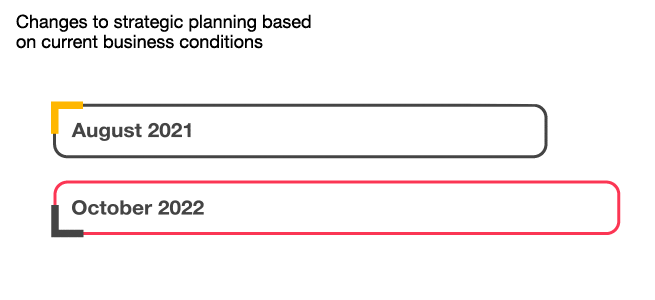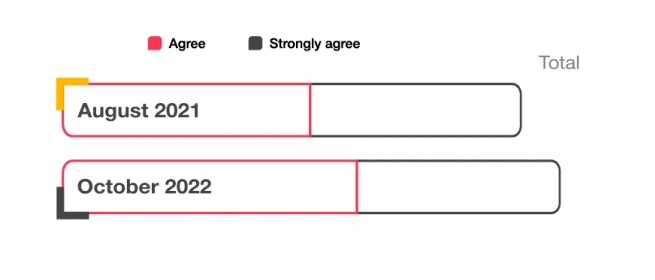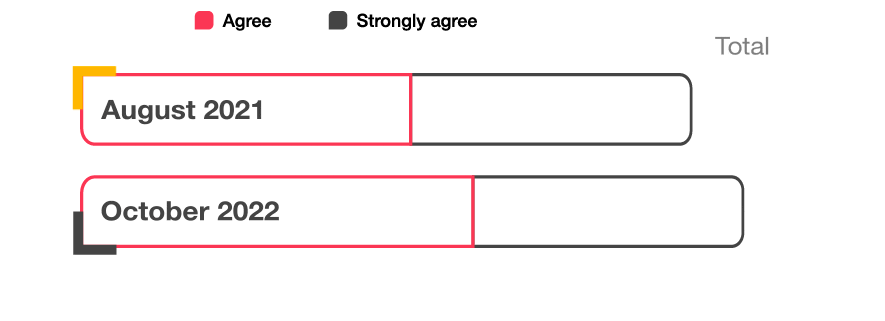
PwC Pulse Survey:
Cautious to confident 2022
Read time: 12 minutes
Finding growth within turmoil
In our third Pulse Survey of 2022, business leaders continue to show optimism despite a backdrop of rapid economic deterioration. After nearly three years dealing with a series of crises, from the pandemic to geopolitical issues to the current economic storm clouds, executives are becoming seasoned, and many are confident about their ability to respond. Executives are switching from a mindset of controlling costs to one that is keenly focused on transformation and targeted growth because it’s the only agenda to take a company forward. How well — and quickly — a company can adapt and transform will help determine who can survive and come out on top.
Key findings
- The economy is center stage: 90% of executives are concerned (34% moderately and 56% very) about macroeconomic conditions — more than any other issue. Four of five (81%) believe a recession is coming within the next six months.
- Business leaders also worry about inflation. Eighty-six percent tell us they’re concerned about the Federal Reserve’s tightening cycle, 82% about wage growth not keeping up with inflation and 81% about declining consumer purchasing power.
- In the next 12 to 18 months, executives are balancing cautionary moves with smart investments to drive targeted growth. Almost half (47%) say they’re making changes to strategic planning based on current business conditions — more than any other activity.
- This balancing act also applies to talent. Forty-four percent are hiring in specific areas to drive growth, 42% are planning cost cutting not including headcount reductions and 26% are planning to reduce the number of full-time employees.
- Signs of confidence are also evident. More than three quarters (77%) are mostly or completely confident that they can achieve near-term growth goals, and 76% are confident in their ability to free up working capital.

Current business environment
90%
of executives are concerned about macroeconomic conditions
The macroeconomic migraine
When asked about their concerns, executives cite a wide range of economic issues. Some 56% are very concerned about macroeconomic conditions and another 34% are moderately concerned. The level of economic volatility facing leadership teams right now is unprecedented.


Inflation, for example, is considered a major threat. Because the US economy is largely driven by consumer spending, a decline in consumer purchasing power poses challenges for companies, with 46% of executives saying they are very concerned. Many consumers are starting to substitute lower quality items to stretch their paychecks. According to PwC analysis, consumers will likely start to take on more debt to maintain spending habits, particularly to get through the holiday shopping season. As of July 2022, real average weekly earnings decreased 3.6% from one year before and have been negative for over a year. Meanwhile, inflation increased 8.5% over those same 12 months.
Inflation pummels real wage growth


In our survey, 45% of executives are very concerned (and another 41% are moderately concerned) about the Federal Reserve’s tightening cycle. The Fed, in an attempt to control inflation and reestablish price stability, has been aggressively raising rates and significantly reducing the size of its balance sheet. Executives have not experienced interest rates this high in 15 years, nor have rates ever increased this quickly. Fed Chairman Jerome Powell has indicated the Fed’s commitment to getting inflation back down to 2%, noting “we anticipate that ongoing increases in the target range for the federal funds rate will be appropriate; the pace of those increases will continue to depend on the incoming data and the evolving outlook for the economy.”


The impact of all these factors hits executives differently. Among the CFOs in our sample, for instance, 33% tell us they’re spending much more time on inflation today compared to a year ago. CMOs are focused on retention and are increasingly personalizing products and services to make their customers less price sensitive. COOs are improving inventory management. Many companies have already passed along price increases to their customers. As the inflationary period drags on, that is becoming a less viable option however, undercutting companies’ pricing power.
Most executives see an economic downturn coming. Thirty-five percent strongly agree that there will be a recession in the next six months. Add in the respondents who agree, and it jumps to 81%. Recession fears can create a self-fulfilling prophecy. When companies hunker down in anticipation of an economic downturn, they conserve cash and scale back spending. When entire industries take this approach, they can create the very situation they were hoping to avoid. Executives should focus on the potential timing and severity of a recession and plan for it.
What companies can do
- Take a deep breath. Most leaders are more familiar with economic situations like what we’re in now than they were for the pandemic in 2020. Draw on the agility you’ve built up over the past few years and revisit your old recession playbooks.
- Focus on scenario planning. Make sure you’re analyzing multiple scenarios, including a deep recession even if you project a shallow one. Examine the impact of each scenario on your company’s bottom line and cash flows. Look at the growth trajectory of your organization for each scenario and develop plans for each area of the business accordingly.
- Stress-test your balance sheet. Assume a worst-case scenario — a profound, long-lasting recession — and determine whether your company has sufficient liquidity and capital reserves to weather the storm. Companies with sufficient cash and foresight can capitalize on the downturn.
- Reassess your pricing and products. Analyze both pricing and product offerings given the current price sensitivity in the market, especially for retail consumers. Try to predict where demand is going and how inflation may impact buying decisions. Stay one step ahead of your competitors by making quick strategic changes to meet the changing needs of consumers.
- Keep trust and transparency in mind. Focus on how you will tell your company’s story as you think about decisions. Your stakeholders may judge you on how you communicate as well as what you do.

Balancing cost cutting with growth
44%
of executives plan to hire in specific areas to drive growth
The strategic response
Business executives find themselves balancing shorter-term cost reduction tactics and longer-term transformation and growth initiatives. Almost half (47%) tell us they’re making changes to strategic planning based on current business conditions (more than any other activity) in the coming 12 to 18 months. That’s a six percentage point increase from August 2021. One change we’ve observed at many companies is a shorter strategic planning cycle. The traditional three-year model offers little value when highly disruptive changes occur more often. Instead, companies are doing strategic planning exercises more frequently and with shorter time horizons.
Executives rev up strategic planning changes


Source: PwC US Pulse Survey, August 19, 2021: base of 752
Q: As you look to the next 12-18 months, which of the following strategic business changes are you making? (Select all that apply)
Source: PwC Pulse Survey, November 2, 2022: base of 657
Companies have been steadfastly focused on cost cutting for the past several years. Our current survey shows many companies are still scaling back in areas that don’t support their strategic growth initiatives. For example, 42% of executives are planning cost-cutting measures other than reducing headcount. And with the era of free money now over, cost consciousness is spreading to all areas of the business. Executives are changing how they manage the business, looking more closely at cash flows and working capital. Many are looking to automation and managed services to create efficiencies and reduce costs further. CIOs overwhelmingly say their businesses are continuing to invest in digital transformation initiatives across the enterprise.
In our current survey, 26% of executives are planning to reduce the number of full-time employees over the next 12 to 18 months. In our August 2022 Pulse Survey, 50% said they had either implemented overall headcount reductions or had a plan in place to do so. At that time, 23% said they had already implemented headcount reductions.
Many executives are now looking beyond headcount reductions to control workforce costs. When we asked CHROs to provide more details in our current survey, 81% told us they’re implementing at least one tactic to reduce their workforce to a great extent. In addition to layoffs, these include voluntary retirement, making performance-based cuts, not replacing people who leave and hiring freezes.
At the same time, executives realize that they can’t cut their way to growth. Rather, they have to build a strategic growth agenda to take the company forward. Over the next 12 to 18 months, 44% of executives plan to hire talent with specific skill sets to drive growth. Companies are also considering M&A, with 35% of respondents planning an acquisition or divestiture in the next 12 to 18 months, up ten percentage points from August 2021. As in all downturns, chaos creates opportunity, and companies with a strong balance sheet can identify potential targets to acquire at discounted prices.
More executives look to M&A in next 12 to 18 months


Source: PwC US Pulse Survey, August 19, 2021: base of 752
Q: As you look to the next 12-18 months, which of the following strategic business changes are you making? (Select all that apply)
Source: PwC Pulse Survey, November 2, 2022: base of 657
It’s tricky to determine the precise impact of the business environment on a company’s bottom line. Only 29% of survey respondents strongly agree that their company does a good job modeling the financial impacts of changing economic conditions. And 23% tell us that business decisions take longer than they did a year ago. This highlights the growing scrutiny around decisions and the heightened expectations to demonstrate ROI.
On the other hand, 77% of executives are confident that they can hit near-term growth goals, and 82% are confident that their company can execute on overall business transformation initiatives. Similarly, 76% are confident that they can free up working capital, and 77% say their organization’s change initiatives will deliver expected results. While margins are coming under pressure, they’re still strong, giving companies room to absorb some of the recession-related risks. Many leaders are positioning themselves to enter a recession from a healthy perspective and exit even healthier.


What companies can do
- Revisit how you approach strategic planning. Shorten your time horizon and be prepared to adjust quickly to changing circumstances.
- Model the impacts of your business decisions. Accelerate your scenario planning efforts and build out multiple projections for different time horizons.
- Be relentless about costs. Consider fit-for-growth cost reduction initiatives to help reduce spending and reallocate those savings to higher-growth business units and segments.

The state of hybrid work
64%
of executives agree their company needs as many people back on-site as possible
Talent challenges and redefining work
For business executives, talent issues continue. Do we have the critical skills needed to succeed? With higher levels of employee burnout, are employees engaged? Can we retain our top talent? Where and how should we expect people to work? How should that vary across job roles in our company? While executives grapple with a fundamental shift in how work gets done, they recognize that there is no one-size-fits-all approach.
Executives are also rethinking the role of the office. After more than two years dealing with pandemic-driven remote work, employees want more flexibility, a better culture and different ways of working. Return-to-the-office policies remain in limbo at many organizations. Among respondents, 64% either agree or strongly agree that their company needs as many people as possible back on-site to achieve their strategic goals. In our August 2021 Pulse Survey, the number was 59%, suggesting that despite the strong demand among employees for flexible work, momentum is growing for a return-to-the-office environment. This varies across industries and geographies.
Employer expectations shift toward on-site work


Source: PwC US Pulse Survey, August 19, 2021: base of 752
Q: In order to achieve our strategic growth goals, our company needs as many people back on-site as possible (Response to ‘Agree’ and ‘Strongly agree’)
Source: PwC Pulse Survey, November 2, 2022: base of 657
Two-thirds (67%) of executives are concerned with the slower than expected return to on-site work. Companies are taking a variety of approaches to encourage people to come back to the office, including a mix of carrot and stick. We asked CHROs what they’re doing to entice people back on-site and if those measures are working. The vast majority (98%) are implementing in-office training, coaching and mentoring opportunities, though only 45% say it’s an effective tactic. While 93% say they’re changing workspaces to improve productivity, just 54% say it is effective.
Across industries, 42% of respondents say that a typical employee is expected to be on-site four or five days per week. On the other end of the spectrum, 11% report that a typical employee needs to report less than one day per week. When looking across sectors, consumer markets and industrial products expect employees to be on-site full-time more than other sectors.


In this world of hybrid work, many executives continue to struggle to create a company culture that promotes an inclusive workplace for all employees. Thirty percent strongly agree (and 39% agree) that management favors on-site over remote workers for advancement and compensation. This can potentially result in a tense work environment. Executives who proactively defuse tension and address this head on can help foster trust with employees, which is critical for companies to realize their overall business goals. The bright spot: 51% of executives are completely confident their companies can maintain a respectful work environment, including fostering diversity, equity and inclusion as well as open discussions of divisive topics.
Get more on this topic
- Read what health industries, financial services and consumer markets executives say about the importance of on-site work
- CFOs recognize the connection between talent and growth. Collaborating with CHROs is an important step to having a strong workforce strategy.
What companies can do
- Don’t leave your corporate culture to chance in a hybrid world. Define employee personas such as fully on-site, hybrid and fully remote. Roles focused on innovation, for example, may need to be on-site more than back-office roles such as finance or tax.
- Create HR policies that promote an inclusive work environment for all employees. Train managers on inclusive leadership to help reduce hybrid work inequity. Set clear expectations for all employees tailored to each employee persona.
- Flexibility. Make sure your talent strategy is centered around flexibility and personalization. Employees who prefer remote roles may opt for those work arrangements as an alternative to dropping out of the workforce altogether.
- Make inclusive leadership a core capability. Focus on developing manager coaching and professional development skills. Equip your leaders with the tools and training they need. For example, help managers coach employees who may have anxiety about their jobs given the current economic environment.

Regulatory and policy environment
43%
of executives are very concerned about a more active regulatory and legislative environment
A new regulatory regime?
While uncertainty around some legislative changes has eased, around US tax, for example, a significant number of executives (43%) are very concerned about a more active regulatory and legislative environment. The SEC’s proposed rules around climate change disclosures and cybersecurity disclosures have boards and risk leaders on alert, and 39% of risk leaders are very concerned about their company’s ability to mitigate compliance and regulatory risk. Executives aren’t waiting for new regulations to get ahead, and 25% are already planning to hire more compliance personnel over the next 12 to 18 months.
Executive concerns extend beyond new rulemaking and laws: 43% are very concerned about political polarization in both the general population and the government.


Cybersecurity is a concern for 88% of executives (with 52% very concerned), and 86% are either monitoring or engaging with lawmakers related to cybersecurity policy. Boards, in particular, are paying close attention to cybersecurity, with 93% of board respondents reporting that they’re either moderately or very concerned. Board members are increasingly attuned to cyber threats and their role in overseeing cyber risk management.
What companies can do
- Invest in compliance. Make sure you have the personnel and the technology to keep up with regulatory issues that will affect or impact your company. Don’t overlook the technology you'll need in areas like ESG to more accurately gather data, track metrics and report performance.
- Strengthen communications. Hot-button social issues are bringing increasing pressure on companies to take a stand, which can have a material impact on shareholder value. Management teams should watch for emerging issues and conduct scenario-planning exercises to have their communications strategy in place before a potential crisis erupts.

Sector implications
Consumer-facing companies take steps to counter economic volatility

As consumer markets executives keep watch on declining purchasing power, they’re considering where to cut costs as they weigh deals and hiring to drive targeted growth.
Possible recession won’t stop financial services’ growth drive

Financial services leaders are banking on a hire-in-a-downturn mindset and technology modernization to boost the top line and fuel profitable growth.
Health industries shift strategic plans to emerge stronger

Health industries executives are focusing on economic concerns, doing business in China and the potential impacts of cyberattacks on both their business and patient care.
Manufacturers looking to weather choppy economy

Industrial products leaders are confident despite a backdrop of concerns around rising interest rates and the potential for cyberattacks.
Tech, media and telecom execs on target for growth, despite macroeconomic threats

As TMT leaders face strong headwinds, they’re more concerned than other sector executives about declines in consumer purchasing power and wage growth failing to keep up with inflation.
Private companies are confident in their company’s resilience

The private sector typically feels the impact of a changing economic environment earlier than public companies — and a recession can hit them harder.
Cautious to confident: What’s top of mind in the C-suite?

About the survey
Between October 12 and October 18, 2022, PwC surveyed 657 US executives, including CFOs and finance leaders (91), CHROs and human capital leaders (94), CMOs and marketing leaders (73), tax leaders (89), risk management leaders, including CROs, CAEs and CISOs (72), COOs and operations leaders (82), CIOs, CTOs and technology leaders (87) and corporate board directors (69). Respondents were from public and private companies in six sectors: industrial products (187), consumer markets (150), financial services (128), technology, media and telecom (99), health industries (64) and energy and utilities (29). The Pulse Survey is conducted on a periodic basis to track the changing sentiment and priorities of business executives.









